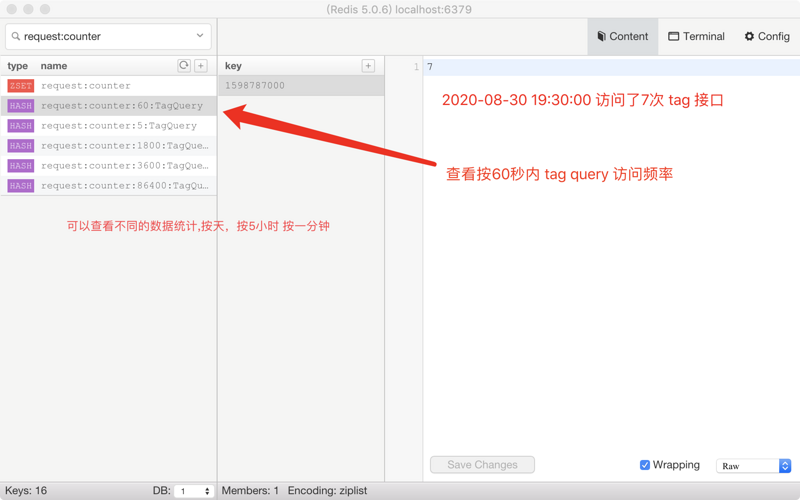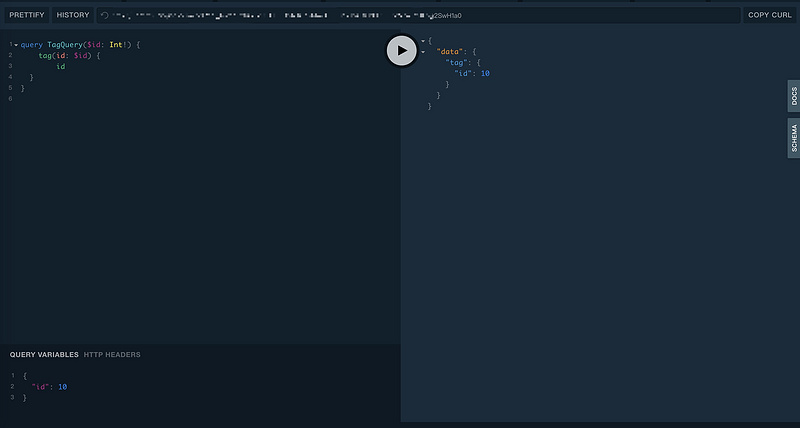这篇文章主要介绍“Laravel中GraphQL接口请求频率案例讲解”,在日常操作中,相信很多人在Laravel中GraphQL接口请求频率案例讲解问题上存在疑惑,小编查阅了各式资料,整理出简单好用的操作方法,希望对大家解答”Laravel中GraphQL接口请求频率案例讲解”的疑惑有所帮助!接下来,请跟着小编一起来学习吧!
前言
起源:通常在产品的运行过程,我们可能会做数据埋点,以此来知道用户触发的行为,访问了多少页面,做了哪些操作,来方便产品根据用户喜好的做不同的调整和推荐,同样在服务端开发层面,也要做好“数据埋点”,去记录接口的响应时长、接口调用频率,参数频率等,方便我们从后端角度去分析和优化问题,如果遇到异常行为或者大量攻击来源,我们可以具体针对到某个接口去进行优化。
项目环境:
framework:laravel 5.8+
cache : redis >= 2.6.0
目前项目中几乎都使用的是 graphql 接口,采用的 package 是 php lighthouse graphql,那么主要的场景就是去统计好,graphql 接口的请求次数即可。
实现GraphQL Record Middleware
首先建立一个middleware 用于稍后记录接口的请求频率,在这里可以使用artisan 脚手架快速创建:
php artisan make:middleware GraphQLRecord
<?php
namespace App\Http\Middleware;
use Closure;
class GraphQLRecord
{
/**
* Handle an incoming request.
*
* @param \Illuminate\Http\Request $request
* @param \Closure $next
* @return mixed
*/
public function handle($request, Closure $next)
{
return $next($request);
}
}然后添加到 app/config/lighthouse.php middleware 配置中,或后添加到项目中 app/Http/Kernel.php 中,设置为全局中间件
'middleware' => [ \App\Http\Middleware\GraphQLRecord::class, \Nuwave\Lighthouse\Support\Http\Middleware\AcceptJson::class, ],
获取 GraphQL Operation Name
public function handle($request, Closure $next)
{
$opName = $request->get('operationName');
return $next($request);
}获取到 Operation Name 之后,开始就通过在Redis 来实现一个接口计数器。
添加接口计数器
首先要设置我们需要记录的时间,如5秒,60秒,半小时、一个小时、5个小时、24小时等,用一个数组来实现,具体可以根据自我需求来调整。
const PRECISION = [5, 60, 1800, 3600, 86400];
然后就开始添加对接口计数的逻辑,计数完成后,我们将其添加到zsset中,方便后续进行数据查询等操作。
/**
* 更新请求计数器
*
* @param string $opName
* @param integer $count
* @return void
*/
public function updateRequestCounter(string $opName, $count = 1)
{
$now = microtime(true);
$redis = self::getRedisConn();
if ($redis) {
$pipe = $redis->pipeline();
foreach (self::PRECISION as $prec) {
//计算时间片
$pnow = intval($now / $prec) * $prec;
//生成一个hash key标识
$hash = "request:counter:{$prec}:$opName";
//增长接口请求数
$pipe->hincrby($hash, $pnow, 1);
// 添加到集合中,方便后续数据查询
$pipe->zadd('request:counter', [$hash => 0]);
}
$pipe->execute();
}
}
/**
* 获取Redis连接
*
* @return object
*/
public static function getRedisConn()
{
$redis = Redis::connection('cache');
try {
$redis->ping();
} catch (Exception $ex) {
$redis = null;
//丢给sentry报告
app('sentry')->captureException($ex);
}
return $redis;
}然后请求一下接口,用medis查看一下数据。


查询、分析数据
数据记录完善后,可以通过opName 及 prec两个属性来查询,如查询24小时的tag接口访问数据
/**
* 获取接口访问计数
*
* @param string $opName
* @param integer $prec
* @return array
*/
public static function getRequestCounter(string $opName, int $prec)
{
$data = [];
$redis = self::getRedisConn();
if ($redis) {
$hash = "request:counter:{$prec}:$opName";
$hashData = $redis->hgetall($hash);
foreach ($hashData as $k => $v) {
$date = date("Y/m/d", $k);
$data[] = ['timestamp' => $k, 'value' => $v, 'date' => $date];
}
}
return $data;
}获取 tag 接口 24小时的访问统计
$data = $this->getRequestCounter('tagQuery', '86400');清除数据
完善一系列步骤后,我们可能需要将过期和一些不必要的数据进行清理,可以通过定时任务来进行定期清理,相关实现如下:
/**
* 清理请求计数
*
* @param integer $clearDay
* @return void
*/
public function clearRequestCounter($clearDay = 7)
{
$index = 0;
$startTime = microtime(true);
$redis = self::getRedisConn();
if ($redis) {
//可以清理的情况下
while ($index < $redis->zcard('request:counter')) {
$hash = $redis->zrange('request:counter', $index, $index);
$index++;
//当前hash存在
if ($hash) {
$hash = $hash[0];
//计算删除截止时间
$cutoff = intval(microtime(true) - ($clearDay * 24 * 60 * 60));
//优先删除时间较远的数据
$samples = array_map('intval', $redis->hkeys($hash));
sort($samples);
//需要删除的数据
$removes = array_filter($samples, function ($item) use (&$cutoff) {
return $item <= $cutoff;
});
if (count($removes)) {
$redis->hdel($hash, ...$removes);
//如果整个数据都过期了的话,就清除掉统计的数据
if (count($removes) == count($samples)) {
$trans = $redis->transaction(['cas' => true]);
try {
$trans->watch($hash);
if (!$trans->hlen($hash)) {
$trans->multi();
$trans->zrem('request:counter', $hash);
$trans->execute();
$index--;
} else {
$trans->unwatch();
}
} catch (\Exception $ex) {
dump($ex);
}
}
}
}
}
dump('清理完成');
}
}清理一个30天前的数据:
$this->clearRequestCounter(30);
整合代码
我们将所有操作接口统计的代码,单独封装到一个类中,然后对外提供静态函数调用,既实现了职责单一,又方便集成到其他不同的模块使用。
<?php
namespace App\Helpers;
use Illuminate\Support\Facades\Redis;
class RequestCounter
{
const PRECISION = [5, 60, 1800, 3600, 86400];
const REQUEST_COUNTER_CACHE_KEY = 'request:counter';
/**
* 更新请求计数器
*
* @param string $opName
* @param integer $count
* @return void
*/
public static function updateRequestCounter(string $opName, $count = 1)
{
$now = microtime(true);
$redis = self::getRedisConn();
if ($redis) {
$pipe = $redis->pipeline();
foreach (self::PRECISION as $prec) {
//计算时间片
$pnow = intval($now / $prec) * $prec;
//生成一个hash key标识
$hash = self::counterCacheKey($opName, $prec);
//增长接口请求数
$pipe->hincrby($hash, $pnow, 1);
// 添加到集合中,方便后续数据查询
$pipe->zadd(self::REQUEST_COUNTER_CACHE_KEY, [$hash => 0]);
}
$pipe->execute();
}
}
/**
* 获取Redis连接
*
* @return object
*/
public static function getRedisConn()
{
$redis = Redis::connection('cache');
try {
$redis->ping();
} catch (Exception $ex) {
$redis = null;
//丢给sentry报告
app('sentry')->captureException($ex);
}
return $redis;
}
/**
* 获取接口访问计数
*
* @param string $opName
* @param integer $prec
* @return array
*/
public static function getRequestCounter(string $opName, int $prec)
{
$data = [];
$redis = self::getRedisConn();
if ($redis) {
$hash = self::counterCacheKey($opName, $prec);
$hashData = $redis->hgetall($hash);
foreach ($hashData as $k => $v) {
$date = date("Y/m/d", $k);
$data[] = ['timestamp' => $k, 'value' => $v, 'date' => $date];
}
}
return $data;
}
/**
* 清理请求计数
*
* @param integer $clearDay
* @return void
*/
public static function clearRequestCounter($clearDay = 7)
{
$index = 0;
$startTime = microtime(true);
$redis = self::getRedisConn();
if ($redis) {
//可以清理的情况下
while ($index < $redis->zcard(self::REQUEST_COUNTER_CACHE_KEY)) {
$hash = $redis->zrange(self::REQUEST_COUNTER_CACHE_KEY, $index, $index);
$index++;
//当前hash存在
if ($hash) {
$hash = $hash[0];
//计算删除截止时间
$cutoff = intval(microtime(true) - ($clearDay * 24 * 60 * 60));
//优先删除时间较远的数据
$samples = array_map('intval', $redis->hkeys($hash));
sort($samples);
//需要删除的数据
$removes = array_filter($samples, function ($item) use (&$cutoff) {
return $item <= $cutoff;
});
if (count($removes)) {
$redis->hdel($hash, ...$removes);
//如果整个数据都过期了的话,就清除掉统计的数据
if (count($removes) == count($samples)) {
$trans = $redis->transaction(['cas' => true]);
try {
$trans->watch($hash);
if (!$trans->hlen($hash)) {
$trans->multi();
$trans->zrem(self::REQUEST_COUNTER_CACHE_KEY, $hash);
$trans->execute();
$index--;
} else {
$trans->unwatch();
}
} catch (\Exception $ex) {
dump($ex);
}
}
}
}
}
dump('清理完成');
}
}
public static function counterCacheKey($opName, $prec)
{
$key = "request:counter:{$prec}:$opName";
return $key;
}
}在Middleware中使用.
<?php
namespace App\Http\Middleware;
use App\Helpers\RequestCounter;
use Closure;
class GraphQLRecord
{
/**
* Handle an incoming request.
*
* @param \Illuminate\Http\Request $request
* @param \Closure $next
* @return mixed
*/
public function handle($request, Closure $next)
{
$opName = $request->get('operationName');
if (!empty($opName)) {
RequestCounter::updateRequestCounter($opName);
}
return $next($request);
}
}结尾
上诉代码就实现了基于GraphQL的请求频率记录,但是使用不止适用于GraphQL接口,也可以基于Rest接口、模块计数等统计行为,只要有唯一的operation name即可。
到此,关于“Laravel中GraphQL接口请求频率案例讲解”的学习就结束了,希望能够解决大家的疑惑。理论与实践的搭配能更好的帮助大家学习,快去试试吧!若想继续学习更多相关知识,请继续关注亿速云网站,小编会继续努力为大家带来更多实用的文章!
免责声明:本站发布的内容(图片、视频和文字)以原创、转载和分享为主,文章观点不代表本网站立场,如果涉及侵权请联系站长邮箱:is@yisu.com进行举报,并提供相关证据,一经查实,将立刻删除涉嫌侵权内容。